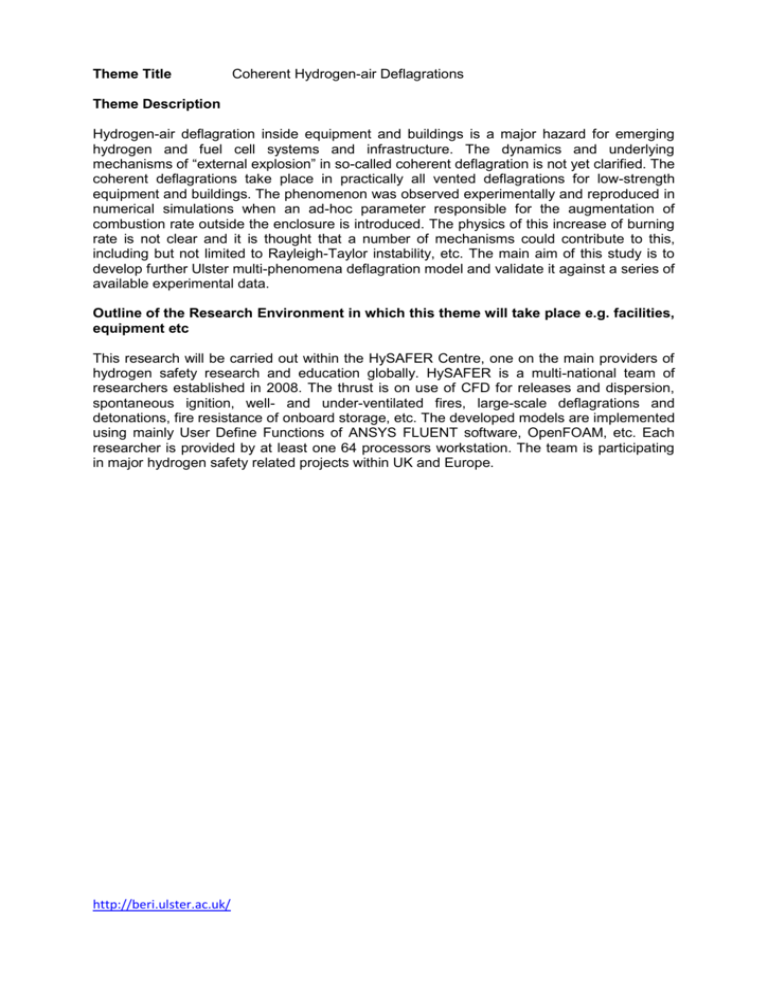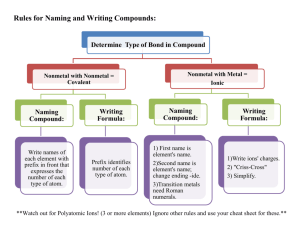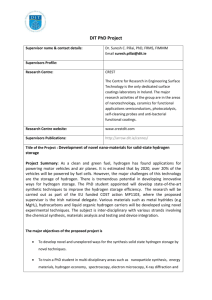Theme Title Coherent Hydrogen
advertisement

Theme Title Coherent Hydrogen-air Deflagrations Theme Description Hydrogen-air deflagration inside equipment and buildings is a major hazard for emerging hydrogen and fuel cell systems and infrastructure. The dynamics and underlying mechanisms of “external explosion” in so-called coherent deflagration is not yet clarified. The coherent deflagrations take place in practically all vented deflagrations for low-strength equipment and buildings. The phenomenon was observed experimentally and reproduced in numerical simulations when an ad-hoc parameter responsible for the augmentation of combustion rate outside the enclosure is introduced. The physics of this increase of burning rate is not clear and it is thought that a number of mechanisms could contribute to this, including but not limited to Rayleigh-Taylor instability, etc. The main aim of this study is to develop further Ulster multi-phenomena deflagration model and validate it against a series of available experimental data. Outline of the Research Environment in which this theme will take place e.g. facilities, equipment etc This research will be carried out within the HySAFER Centre, one on the main providers of hydrogen safety research and education globally. HySAFER is a multi-national team of researchers established in 2008. The thrust is on use of CFD for releases and dispersion, spontaneous ignition, well- and under-ventilated fires, large-scale deflagrations and detonations, fire resistance of onboard storage, etc. The developed models are implemented using mainly User Define Functions of ANSYS FLUENT software, OpenFOAM, etc. Each researcher is provided by at least one 64 processors workstation. The team is participating in major hydrogen safety related projects within UK and Europe. http://beri.ulster.ac.uk/ Theme Title Delayed Ignition of High-pressure Hydrogen Jets Theme Description Pressure effects from deflagrations of high-pressure hydrogen jets can be harmful for human and could damage or destroy civil structures. Release of hydrogen jet into air can be ignited immediately, e.g. by diffusion mechanism of spontaneous ignition, or with some delay when the jet reaches an ignition source. Contemporary tools (e.g. CFD ) should be developed for hydrogen safety engineering to predict the dynamics of pressure generated by combustion of turbulent hydrogen jet in air (both outdoors and indoors). Results of simulations can be used, when validated against experimental data, for development of predictive engineering correlations when the deflagration overpressure could be calculated as a function of storage pressure and release diameter (plus enclosure volume and vent size for indoor deflagration). Modelling of this combustion process could be done by the Ulster multi-phenomena turbulent burning velocity model, which needs an update, or by another model, e.g. based on the eddy dissipation concept. The ignition could happen with a longer delay, e.g. when a flammable layer is formed in an enclosure. Within this theme a method of calculation of flammability limits for hydrogen-oxygen-nitrogen-water mixtures at elevated temperatures and pressures will be developed as well using tools like CFD with inclusion of chemistry. Outline of the Research Environment in which this theme will take place e.g. facilities, equipment etc This research will be carried out within the HySAFER Centre, one on the main providers of hydrogen safety research and education globally. HySAFER is a multi-national team of researchers established in 2008. The thrust is on use of CFD for releases and dispersion, spontaneous ignition, well- and under-ventilated fires, large-scale deflagrations and detonations, fire resistance of onboard storage, etc. The developed models are implemented using mainly User Define Functions of ANSYS FLUENT software, OpenFOAM, etc. Each researcher is provided by at least one 64 processors workstation. The team is participating in major hydrogen safety related projects within UK and Europe. http://beri.ulster.ac.uk/ Theme Title Development of Online Hydrogen Safety Engineering Tools Theme Description Hydrogen safety requires development of fundamentally based and thoroughly validated analytical models and based on them engineering tools. New analytical models are being developed and published by different research teams on annual basis, including essential contribution to these tools by the HySAFER team at Ulster. The candidate is expected to work on analysis of existing and development of new analytical tools, their validation against representative experimental data, and, finally, implementation into online Cyber-Laboratory for free use of all stakeholders in the area of hydrogen and fuel cell technologies. Research may include but not limited to development of tools for definition of separation distances based on hazards associated with pressure, thermal effects, radiation, hydrogen release etc. The candidate will also be encouraged to use and/or contribute to development of CFD modelling tools as essential part of contemporary safety engineering. It is expected that CFD HyFOAM tool will be developed further with introduction of new sub-models. This CFD tool will be validated against various problems of non-reacting releases and dispersion, jet fires, deflagrations and detonations, blast waves and fireballs, etc. It will be used also for cross-validation of engineering correlations and analytical tools against CFD simulations. Outline of the Research Environment in which this theme will take place e.g. facilities, equipment etc This research will be carried out within the HySAFER Centre, one on the main providers of hydrogen safety research and education globally. The research will contribute to Online Cyber-Laboratory initially created under European H2FC Infrastructure project (www.h2fc.eu), which is a unique gathering of models and tools for hydrogen safety engineering, including those published in free download eBook “Fundamentals of hydrogen safety engineering” (www.bookboon.com) and developed up to now in Ulster. Update of both parts of Online Cyber-Laboratory - analytical models for online calculation of hazards, and a comprehensive HyFOAM tool for CFD simulations (based on OpenFOAM) – is anticipated. http://beri.ulster.ac.uk/ Theme Title Fire Performance of On-board Hydrogen Storage Accounting Effect of Pressure Relieve Device Theme Description The main strategy for inherently safer use of hydrogen-powered vehicles, especially in fire conditions, is simultaneous decrease of TPRD (thermally activated pressure relief device) venting area and corresponding increase of fire resistance rating of on-board storage tank. However, testing of a storage tank with TPRD following the bonfire test protocol does not allow concluding on the performance of the assembly of the tank and its TPRD in all realistic fire conditions. Deterministic separation distances from unignited and ignite release have to be estimated taking into account jet attachment to the ground and buoyancy effects. The comparison of different TPRD nozzles will be simulated to reduce flame length. Effect of generation of water vapour during combustion of hydrogen released from TPRD with reduced mass flow rate on primary fire in a garage will be studied for selected scenarios. Outline of the Research Environment in which this theme will take place e.g. facilities, equipment etc This research will be carried out within the HySAFER Centre, one on the main providers of hydrogen safety research and education globally. HySAFER is a multi-national team of researchers established in 2008. The thrust is on use of CFD for releases and dispersion, spontaneous ignition, well- and under-ventilated fires, large-scale deflagrations and detonations, fire resistance of onboard storage, etc. The developed models are implemented using mainly User Define Functions of ANSYS FLUENT software, OpenFOAM, etc. Each researcher is provided by at least one 64 processors workstation. The team is participating in major hydrogen safety related projects within UK and Europe. http://beri.ulster.ac.uk/ Theme Title Hazards from Catastrophic Failure of High-pressure Hydrogen Storage Theme Description The study will focus on hazards associated with extremely high pressures and relatively large volumes for hydrogen storage at refuelling stations and onboard of vehicles. There is experimental data indicating that the largest deterministic separation distance is not due to jet fire but a fireball and radiation from it following rupture of high-pressure hydrogen storage in a fire. Additionally, for a large volume storage the separation due to the blast wave is significant and especially hazardous for first responders due to the fact that the blast wave will propagate in all direction (opposite to the jet flame from TPRD which is expected to have preferable direction). CFD tools will be used to get insight into the phenomena and carry out a parametric study. Based on available experimental data and results of numerical study it is expected that engineering tools will be developed and validated for assessment of blast wave decay and radiation from fireballs. Outline of the Research Environment in which this theme will take place e.g. facilities, equipment etc This research will be carried out within the HySAFER Centre, one on the main providers of hydrogen safety research and education globally. HySAFER is a multi-national team of researchers established in 2008. The thrust is on use of CFD for releases and dispersion, spontaneous ignition, well- and under-ventilated fires, large-scale deflagrations and detonations, fire resistance of onboard storage, etc. The developed models are implemented using mainly User Define Functions of ANSYS FLUENT software, OpenFOAM, etc. Each researcher is provided by at least one 64 processors workstation. The team is participating in major hydrogen safety related projects within UK and Europe. http://beri.ulster.ac.uk/







